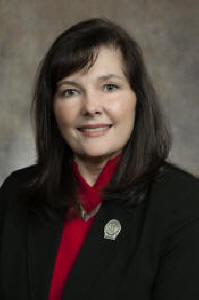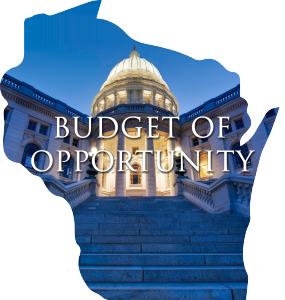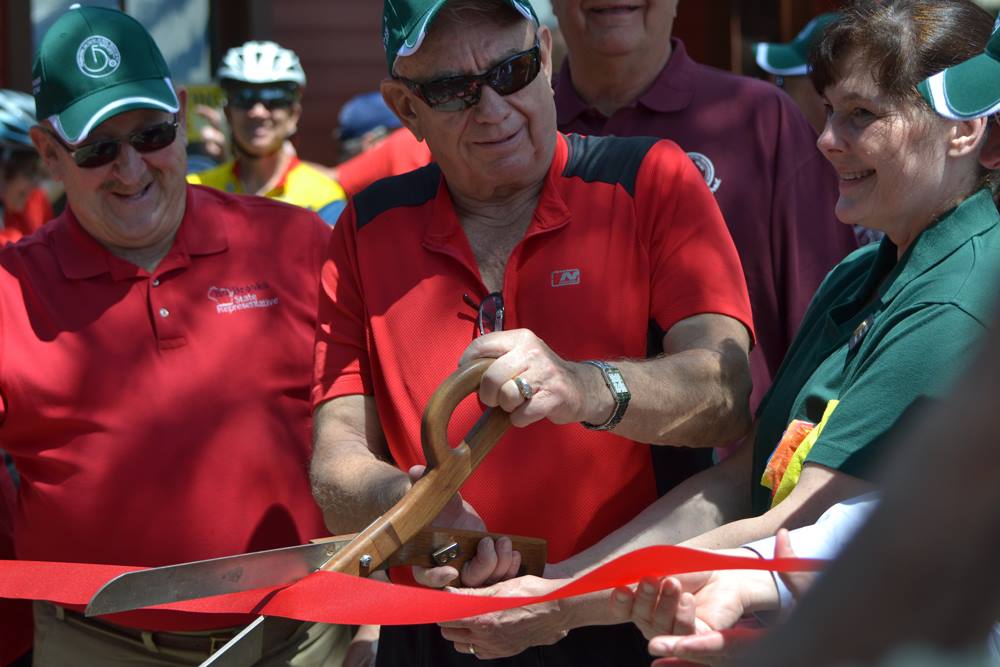News from Nancy!

I hope
everyone is doing well and staying dry! It's hard to believe we are almost half way through
June already. There has been a lot happening since the last time I
sent an update. I have been busy meeting with constituents and attending
events in the district. In Madison, I've been working with
my colleagues to improve
the state budget and the Assembly was on the floor earlier this week.
Many
people commented about reading my last
budget column so I thought it would be a good idea to write a
public education column. This will be a good opportunity to share my
latest column and
fill you in on what's been going on.
Column: Improving Public
Education in the State Budget
When
I announced my candidacy for the state Assembly, there were a handful of
things I pledged to tackle if I were to be lucky enough to be elected. One
of those items was finding ways to reinvest and renew our state’s support in
public education.
Knowing that much of this conversation would be centered on our state’s next
budget, I’ve spent my first several months in office crisscrossing the
district to tour our schools and meet with administrators and parents. My
goal was to see the success stories and work to better understand challenges
facing our schools.
Now working its way through the legislative review process, I’m proud to
have championed several initiatives in the state’s next budget that will
help our schools make investments in the classrooms and deliver the services
our children need and deserve.
When I brought the feedback I received in our district with me to Madison,
one of the findings I shared with my colleagues was that no two schools are
exactly alike. However, one commonality that I found in speaking with our
area schools was a universal need for increased student aid.
On this front, I’m proud to say we delivered.
Unlike the governor’s initial proposal that reduced per pupil aid, I
supported a plan that not only wiped out the proposed reduction, but
actually increased the state’s investment in schools by $100 per student.
Statewide, that math adds up to be an increased investment of $200 million.
That’s real money that can be used to make a real difference in our
classrooms.
Additionally, one of the unique challenges that our schools face is the
rural nature of our communities, sometimes spanning over hundreds of square
miles. This means our districts bear a higher cost in helping to transport
our children to and from school each day.
Recognizing that unique challenge, the reform package I supported that’s now
included in the budget not only provides an additional $5 million to help
rural districts offset increasing transportation costs, but it also
increases sparsity aid by $8.4 million.
Since we know that K-12 is only part of our state’s robust public education
system, I’ve also worked to make sure our students have access to the
preparatory and secondary courses they need to successfully enter the
workforce.
During a recent visit to Sparta High School, I had a chance to see how the
school was using a partnership with UW-Richland County to give their
students a leg up. As I learned, these high school students were actually
able to receive college credit while taking advanced level courses. While
these courses helped to reduce tuition for students and give them a
jumpstart on their college careers, the program was in jeopardy of being cut
because of the high administrative costs the Sparta district was bearing.
I’m proud to say that working in conjunction with our UW System, a
compromise was reached that will allow schools like Sparta to maintain these
course offerings without bearing an unfair cost burden in administering
them.
Not only that, but I’m pleased to say we’ve worked to extend the tuition
freeze on all UW campuses – helping to make college more affordable and
attainable for families in our communities.
My point in telling you all this is to hopefully demonstrate how committed I
remain to finding ways to help our public school systems. Although I wish I
had more space to touch on all the great things this budget does for our
students, I think that many of the items I’ve mentioned here showcase just
some of the positive changes being made for the future of our state.
As a small businesswoman, I realize how important it is that we live and
spend within our means. But as an aunt of several public school students,
just like you, I want to see my family members receive the finest education
possible.
Balancing these priorities with the many other needs and services provided
through the state isn’t always the easiest work, but I remain committed to
finding ways to make this the best budget it can be for Wisconsin and our
children.
An Update on the State Budget

The 2015-17 state budget is currently before
the budget-writing Joint Finance Committee (JFC) for consideration. The
issue areas remaining to be tackled by the JFC are General Fund Taxes,
Department of Revenue, Sports and Entertainment District, and the Department
of Transportation. The State Assembly is expected to vote on the budget
around the end of June before being signed into law by Governor Walker.
There are still areas of the budget that I would expect to see changed or
clarified. Specifically, I would like to see Motion 457 relating to
Alternative Teacher Licensure clarified. I would like it to be rolled back
from what it currently is so that it only applies to non-core class
instructors.
Many of our school districts, particularly in the rural areas like the 70th
Assembly District, simply do not have the resources or personnel to offer
many of the elective courses and additional learning opportunities that are
available to students in more urban areas.
This alternative teacher licensing option was identified by the Rural
Schools Task Force during the 2013-14 legislative session as a way to allow
people from the community to offer their skill and industry expertise in the
classroom, to provide a learning opportunity that otherwise the student may
not get. For example, a local experienced mechanic could teach a section of
an auto mechanics class at the local high school; an elective course that
the district may not have the resources for or high enough student demand to
warrant a full-time staff position. There are a few key points to keep in
mind.
First, this alternative license proposal is completely optional.
No school district or board is required to use this option if it does not
wish to, however it does provide our school boards with that choice. The alternative license is not intended to dilute or compete with a
traditional four-year teaching degree.
Second, an alternative license would only be valid for the district where
that person was deemed qualified. It cannot be transferred to any other
district in the state. The entire basis of the alternative license is that
local districts know best the needs of their own classrooms and can identify
those skilled members of the community that could give back by helping the
next generation of learners.
Third, any person holding an alternative teacher license could not be a
full-time employee of the district. That was a main concern that has been
raised, and it was never the intent for an alternative license holder to be
full-time staff.
I would also like to note that several of the other recommendations
identified by the task force are included in the proposed budget, including
whole grade sharing, broadband access, the TEACH program which provides
additional digital learning options, increase sparsity aid (additional $8.4
million) and high cost transportation aid (additional $5 million).
Rep. VanderMeer Supports Paper
Industry in State Budget
Fights to Secure Funding for UW-Stevens Point Paper Science Program
I am happy to announced that the legislative
Joint Finance Committee (JFC) approved my request to increase support for
UW
Stevens Point’s Paper Science & Engineering program in the state’s next
budget. The request, offered in conjunction with Rep. Scott Krug
(R-Nekoosa), will provide $124,400 to help support the university’s goals of
providing training and on-the-job experience for students looking to begin
careers within paper industries.
The UW-Stevens Point Paper Science &
Engineering program provides students with the tools and education they need
to prepare for successful careers in the paper industry. Boasting an
impressive one-hundred percent post-graduate placement rating with
employers, according to the university, roughly half of all graduates go on
to find jobs in Wisconsin – helping to build our communities with
good-paying, family-supporting jobs.
Whether it’s in the mills in Wood and Portage counties or in the forests of
Monroe and Jackson counties, paper production and the forestry industry
supports countless families throughout our communities. Preserving this
important program on the Stevens Point campus will help to ensure that
Wisconsin remains a leader in paper production and that our students are
receiving the skills they need to successfully enter the workforce.
Elroy-Sparta Bike Trail 50th
Anniversary Celebration
 Last
Saturday, I had the honor of cutting the ribbon for the 50th anniversary
celebrating of the Elroy-Sparta Bike Trail. Governor Tommy Thompson
was the featured guest speaker providing historical background on a great
recreational gem. It’s pretty incredible to have the nation’s first
rail-to-trails bike path. Our area’s 32 miles led to over 22,000 miles of
similar trails across the country. Last
Saturday, I had the honor of cutting the ribbon for the 50th anniversary
celebrating of the Elroy-Sparta Bike Trail. Governor Tommy Thompson
was the featured guest speaker providing historical background on a great
recreational gem. It’s pretty incredible to have the nation’s first
rail-to-trails bike path. Our area’s 32 miles led to over 22,000 miles of
similar trails across the country.
Several
hundred riders and supporters of the trail joined together Saturday
afternoon for a 50th Anniversary Commemoration! The Tomah Journal wrote an
article about the wonderful event. I encourage you to check it out!
Sincerely,
 |

